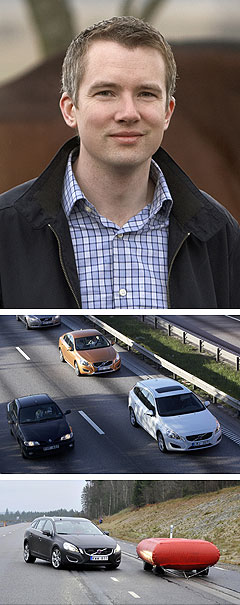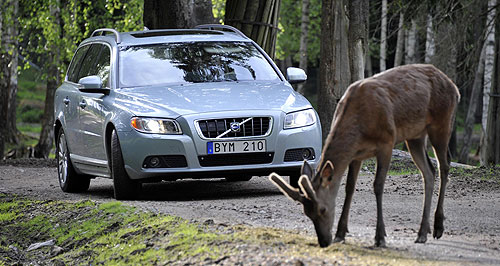News - VolvoVolvo working on animal avoidance techBeastly: Each year 47,000 animal collisions are reported in Volvo’s native Sweden and tens of thousands happen in the back blocks of Australia. Animal avoidance, intersection assist and traffic jam ‘autopilot’ for future Volvos16 Jul 2012 DRIVING on Australian country roads between dusk and dawn could become less perilous in coming years as Volvo is developing a system that recognises animals at highway speeds and helps avoid – or reduce the seriousness of – a collision by automatically applying the brakes. As part of its goal that no person should be killed or seriously injured in a new Volvo car by 2020, the Swedish carmaker is also working on systems that avoid accidents at intersections and take control during tedious traffic jams to reduce driver frustration and boredom. The systems are being developed in response to increasing distractions to drivers and Volvo cites studies in the US revealing that modern drivers spend between 25 and 30 per cent of time behind the wheel making phone calls, checking emails or texting. Volvo’s Animal Detection system, an extension of its existing pedestrian protection technology, aims to reduce the number of serious accidents that result from striking or avoiding animals that come onto the road. Road toll statistics rarely implicate wildlife or livestock in single-vehicle accidents when a driver has lost control or hit another vehicle by swerving to avoid an animal, but an Australian study of animal-related road accidents between 1990 and 1997 revealed 42 per cent of animal-related road fatalities involved drivers taking evasive action. More than 10,000 crashes with or involving animals on the road were reported across Queensland, Victoria and New South Wales between 2001 and 2005.  From top: Volvo's Andreas Eidehall Autonomous Driving Support Intersection Support. From top: Volvo's Andreas Eidehall Autonomous Driving Support Intersection Support.In Sweden, 47,000 animal collisions are reported each year and 40,000 are reported in Canada, while 200 road deaths per year in the US are attributed to impacts with animals. Volvo’s new system aims to reduce the speed of impact from between 100km/h and 110km/h to less than 80km/h, when safety systems such as airbags are more likely to protect the car’s occupants from the impact. A camera with infra-red night-vision detects animals from up to 30 metres away and Volvo engineers first concentrated on calibrating the system to recognise large animals such as stags and elk, which cause the worst injuries to vehicle occupants when struck, but are also including horses and cows. Volvo technical expert of active safety Andreas Eidehall said the next step is to work on recognition of smaller animals such as deer and wild boar, but whether Australian wildlife like kangaroos and wombats will be included remains to be seen. “The gathering of images of animals in motion takes place on a continuous basis, but since wild animals have in many respects mastered the art of staying out of sight, this is a complex process” said Mr Eidehall. “There is a huge challenge in collecting data that helps us understand how we can detect what nature has done its best to conceal.” Crashes occurring at intersections account for 21.5 per cent of road fatalities in the US and 20.6 per cent across 16 European countries. Volvo’s Intersection Support system is designed to step in by alerting the driver and automatically braking if an impending impact is detected when turning across the path of oncoming traffic. It aims to mitigate mistakes made by the driver, such as misjudging other drivers’ intentions or vehicle speed and the mistakes of other road users, such as running a red light. Although no mention of Melbourne’s infamous hook turns are mentioned, Volvo claims the system is being calibrated against driving styles and conditions the world over and, as such, will be “equally capable of helping drivers in Bangkok and Vancouver”. Volvo’s Active Safety Functions engineer responsible for Intersection Support, Mattias Brannstrom, said the technology is “trying to do the same thing that people would do in the same situation if they have time to react”. “The sensors are the eyes, the computers are the brain and the brakes are the muscles … If a critical situation is registered, a decision to intervene is taken at lightning speed.” A function that will provide relief to commuters is Autonomous Driving Support, which goes beyond existing adaptive cruise control systems by using cameras and radars to control the car’s speed and steering when driving in slow-moving traffic queues. Volvo claims the system will reduce the number of mistakes made by bored and distracted drivers in a traffic jam environment, while allowing them to re-take control at any time. In its first generation, Autonomous Driving Support will accurately keep the car in lane and follow the vehicle in front, even copying a swerve made to avoid an obstacle, while maintaining a safe distance. Further developments will enable the system to handle more complex traffic scenarios and work at higher speeds. All three systems are expected to reach production Volvo models within a few years. Volvo senior manager of safety strategy and requirements Jan Ivarsson said the conception and development of the systems was “quite simply a matter of creating technology that provides the driver with the right support at all times”. “With steadily lower prices for sensors and other electronic components, it is our intention that these advanced solutions will in future be fitted to all our cars. “Close cooperation with the relevant public authorities, insurance companies and other car manufacturers is also vital for achieving the vision of an accident-free traffic environment.” A study of insurance claims conducted last year by the US Highway Loss Data Institute (HLDI) showed Volvo’s City Safety system to be effective for reducing low-speed crashes in the real world. Volvo XC60 SUVs fitted with the system were involved in 27 per cent fewer claims for third-party property damage arising from accidents such as rear-ending in a traffic jam than other similarly sized luxury SUVs. The HLDI more recently published findings showing autonomous braking systems and adaptive headlights resulted in reduced insurance claims, but claims increased for cars fitted with lane-departure warning systems. Euro NCAP recently announced it will start including autonomous braking in its star ratings from 2014 to encourage more manufacturers to fit it as standard and Australasian NCAP will make ‘safety assistance technologies’ mandatory for a five-star rating from next year.  Read more6th of July 2012  Mixed results for crash-avoidance techUS insurance study reveals not all crash-avoidance technologies reduce crashes3rd of July 2012  Government considers more safety legislationFederal legislators consider making more safety tech mandatory as road toll declines20th of June 2012  ANCAP announces tighter tests for 2017Amended roadmap focuses on making low-scoring cars safer as ANCAP tightens for 2017 |
Click to shareVolvo articlesResearch Volvo Motor industry news |
















Facebook Twitter Instagram